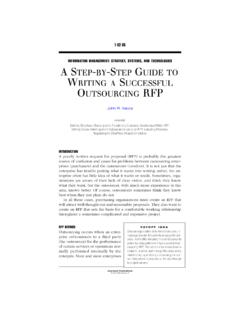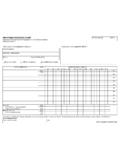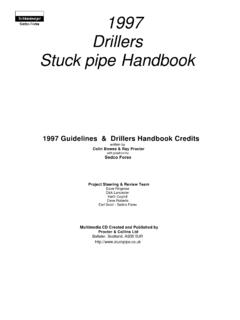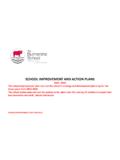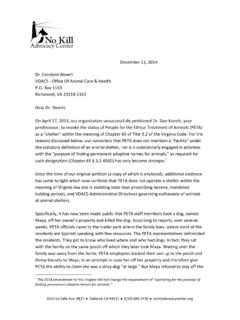Transcription of TEACHER MANUAL - Connecticut
1 GUIDANCE ACTIVITIES COLLEGE PLANNING FOR STUDENTS WITH DISABILITIES TEACHER MANUAL Working Draft Autumn 2002 POST-ITT POSTSECONDARY INNOVATIVE TRANSITION TECHNOLOGY Lee F. Bassett Debra Zawada Kristin Rytter The contents of this book were developed under a grant from the United States Department of Education Office of Special Education Programs; CFDA , project number H078C70040-99. However, these contents do not represent the policy of the Department of Education, and you should not assume endorsement by the Federal Government. Table of Contents - i - Introduction Rationale ..1 Getting started ..2 Resources ..9 Section 1 Self-Advocacy Rationale ..11 Getting Started ..12 Activities Section 2 Assistive Technology Rationale ..32 Getting Started ..33 Activities Section 3 Planning for College Rationale.
2 46 Getting Started ..46 Activities Section 4 Applying to College Rationale ..67 Getting Started ..67 Activities Section 5 Disability Services Rationale ..85 Getting Started ..85 Activities Table of Contents - ii - Section 6 Adult Services 99 Rationale .. 99 Getting Started .. 99 Activities 44-45 ..100 Planning Worksheet Section 1 Self-Advocacy Activity 2 Sample Letter Activity 2 Interview Questions Activity 8 Self-Advocacy Speech Section 2 Assistive Technology Activity 10 Self Evaluation Guide Section 3 Planning for College Activity 19 Job Information Activity 20 Goal Setting: Adult Interview Activity 21 Discussion Guide/Future Planning Activity 24 College Planning Calendar Section 4 Applying to College Activity 26 Letter Requesting Information Section 5 Disability Services Activity 38 Disability Services Comparison Activity 40 Disability Documentation Evaluation Section 6 Adult Services Activity 45 Vocational Rehabilitation Department Introduction Page 1 Welcome to the Post-ITT Guidance Activities.
3 When used with the Post-ITT Website these Activities help students with disabilities reach the goal of going to and succeeding in college. This TEACHER MANUAL gets you started and gives you hints on additional resources. General strategies for planning are introduced for each section. Each Activity is introduced with teaching suggestions as well as supplementary resources and detailed evaluation questions. Use the Activities with individual students or in class. The Guidance Activities are organized in six sections: Self Advocacy Assistive Technology Planning for College Applying to College Disability Services Adult Services The Activities require students to research, process, report, and take action. Some Activities ask them to repeat their research to broaden their knowledge or increase the depth of understanding.
4 Students are expected to take the initiative in most Post-ITT Activities by using the Internet and conducting in-person interviews. The Post-ITT Website provides a portal to much of the information needed. Rationale for Post-ITT Researchers at Washington Research Institute developed the Guidance Activities in partnership with the Lake Washington School District and the Washington Association of Postsecondary Education and Disability (WAPED). WAPED members are primarily college disability services (DS) coordinators, who assist students with disabilities, access academic adjustments, and auxiliary aids that are appropriate. Initially, developers intended to create a simple worksheet for seniors to use to make contact with the disability services office at a college of interest. The need for a more comprehensive approach emerged from interviews conducted with college students, disability services coordinators, and high school teachers and students.
5 Here are some of the findings and the conclusions that were drawn from those interviews. Finding: Students with disabilities had only a rudimentary or inaccurate understanding of their disabilities and how those disabilities might functionally limit them in college. Disability services (DS) coordinators reported that one of the biggest problems they encountered was that students did not understand their disability and how it functionally limited them in college. This knowledge is fundamental to accessing college disability services. Disability awareness, learning how a disability is documented, and discovering the relationship between disability and functional limitations are threads woven through all of the Activities. Finding: Although most students were familiar with the concept of advocacy, few had advocated for their own accommodations.
6 Although most high school students had some experience with accommodations, few had advocated for their own needs and fewer still had made arrangements for accommodations. The Activities help students understand the relationship between disability and accommodation. They are introduced to the disability documentation and discover that there is a relationship between that documentation and the services they will be eligible to receive. Finding: Few college or high school students with disabilities used the high school guidance counselor as a resource in college transition. High school students surveyed were not engaged in many of the pre-college activities that most students without disabilities do. They did not typically take pre-college tests, go to college seminars or use the guidance counselors. The Activities engage the students in using all of the resources available to them in school, especially guidance counselors.
7 Introduction Page 2 Finding: Few high school students understood the differences between special education and college disability services. Students must understand that the system of services that they have come to expect from public high schools will no longer apply in college. The Activities teach how the purposes of the institutions (K-12 schools and colleges) are different, the laws that apply differ, and consequently, how the services will be different. Finding: Most prospective college students didn t know who to contact for disability services, what to expect, or how to get started. The Activities introduce the college office of disability services (DS) as a way of gaining access to instruction. Later, students go through a step by step process of making a call, asking questions, finding out about disability documentation, and finally meeting with a disability services coordinator.
8 When to Introduce the Guidance Activities The Activities should be introduced in the 9th grade and continued through the senior year. This gives students time while still in high school to learn and an opportunity to practice the skills they will need in college. The diagram on the next page illustrates the Post-ITT Guidance Activities model and the sequence of its major sections. Getting Started With Post-ITT Activities Each of the Sections and Activities has suggestions for getting started. The following gives you a more general orientation. Becoming Familiar with the Curriculum Time spent becoming familiar with these Activities will increase your comfort as a facilitator and result in better outcomes for your students. Here are a few preliminary steps. Preview each of the 45 Activities and list the people and other resources in your school and community whom you might involve.
9 Visit the Post-ITT Website and become familiar with its content and structure. Investigate some of the Websites listed in the supplementary resources. With the Activities in mind, think about your students. Who will need help with the computer? Who needs a partner? Who won t feel comfortable? How and when will you contact parents? Consider how you will modify the Activities to accommodate the learning needs of your students. Think about your school calendar and unit planning. When and where will you introduce groups of Activities? Consider whether you will be using the Activities as part of group instruction, as individual assignments, or some combination based on student need, resources available, and time. Who can assist you? How do these Activities overlap with what your school counselors, psychologists, or others are already doing or want to do?
10 What community resources (such as the Learning Disabilities Association, state agencies, and college disability services offices) would be willing to lend a hand? 9 12 Progressing from 9 th through 12 grades Post - ITT Guidance Activities Returning to earlier activities for more practice as necessary 10 11 S uccessful Transition to College Introduction Page 5 Getting Started with Your School Post-ITT Activities ask students and high schools to begin to simulate the college experience of students with disabilities. It is important that you have a good understanding of the difference between the two systems. Let s compare the two. In the public schools, the special education service delivery model expects school personnel to be trained and knowledgeable professionals who assess, prescribe, implement, and evaluate.










